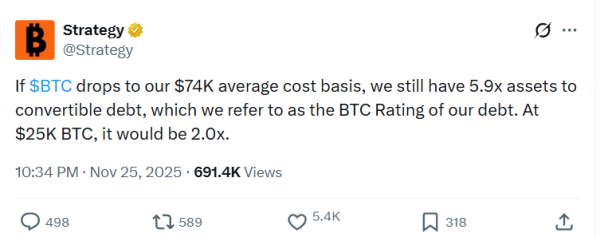Strategy is choking: panic, debt, and a tweet that only made things worse

Strategy (MicroStrategy), the largest publicly traded Bitcoin investor, claims its assets cover convertible debt even if Bitcoin falls to $25,000. The post comes at a time when the company is facing pressure from a combination of factors: the threat of being delisted from MSCI, a decline in mNAV, and the perception that its debt structure is unsustainable.
We explain what's wrong with Strategy's position, why many considered the company's latest post an attempt to justify itself, and whether we should fear the collapse of the largest publicly traded BTC investor.
What Strategy Says
In its announcement, the company stated that even if Bitcoin falls to its average purchase price of $74,000, it maintains a 5.9x asset coverage of its convertible debt. Simply put, according to Strategy, the value of its assets is approximately six times the amount of debt that could be converted into equity in the future.
 Screenshot of the Strategy post
Screenshot of the Strategy post
If Bitcoin were to fall back to $25,000, the ratio is expected to remain around 2.0. The company calls this the BTC Debt Rating—a new term intended to convey the impression of a well-thought-out and sustainable structure.
The tone of the post is calm, but its appearance is already a consequence of pressure. Strategy is forced to explain its position more often than it would like.
Strategy's Problems and Key Complaints
The company has developed a whole host of vulnerabilities. They are uneven in severity, but together they create significant pressure.
Available funds and liabilities:
- there are only about $54 million in the accounts;
- annual payments on preferred shares – about $700 million;
- The operating business is unprofitable and does not cover the debt burden.
The financial model has stopped working. Previously, issuing new shares worked like this:
- the stock price was higher than the price of Bitcoin per share;
- each new issue provided the company with more Bitcoin per unit of share capital;
- Shareholders received indirect benefits from the increase in Bitcoin reserves.
In the fall of 2025, this system broke down. The share price no longer offered a premium, and issuing new shares now resulted solely in share dilution. Now, share dilution is the only noticeable effect, meaning each new share issue increases the number of shares outstanding, reduces the stake of existing investors, and brings no additional value to the company in the form of new Bitcoin.
Essentially, Strategy is issuing new shares, which reduces the stakes of existing shareholders, and in return, the company no longer receives the additional bitcoins that once underpinned its entire model.
Additional pressure factors:
- risk of exclusion from MSCI indices on January 15, 2026;
- potential mechanical sales of approximately $2.8 billion;
- total capital outflow up to $8.8 billion;
- Bitcoin liquidity squeeze during stressful periods;
- 649,870 bitcoins on the balance sheet – approximately 3.26% of the emission.
Selling even a portion of this volume with reduced liquidity could lead to significant price pressure. The market remembers October 10th, when order book depth collapsed by 90%.
Many investors also note that Strategy operates as if its access to capital is unlimited. In reality, it has narrowed, and this is precisely what is causing growing concern.
Reaction of the crypto community
The responses to the X post were harsh. Some readers saw nervousness in the post. Others believe the BTC Rating is a slick gimmick with no real analytical value.
The post is heavily laced with sarcasm: some readers are openly ridiculing the situation. Others express disbelief and doubt that Strategy's assets will maintain their stated value in this stressful environment. There's also irritation—some see the “borrow and buy Bitcoin” strategy as a risk for the entire market. There are also more somber comments: people read the post not as an attempt to reassure, but as an alarming sign of impending trouble.
“Their posts are tinged with fear. The maximalists understand that a drop below $74,000 is inevitable,” financial analyst Jacob King commented on Strategy's post.

With January's risks looming, any justification for Strategy is louder than usual, creating the sense that the company is losing control of the narrative.
Conclusions
The situation surrounding Strategy demonstrates how the corporate debt model is confronting the limitations of the real market. The company publishes accurate figures and new terms, but the audience's reaction highlights a decline in trust. The market is waiting not for another tweet, but for concrete steps, and the tension around Strategy will only intensify as the January decisions and potential sell-offs approach.
Source: cryptonews.net



